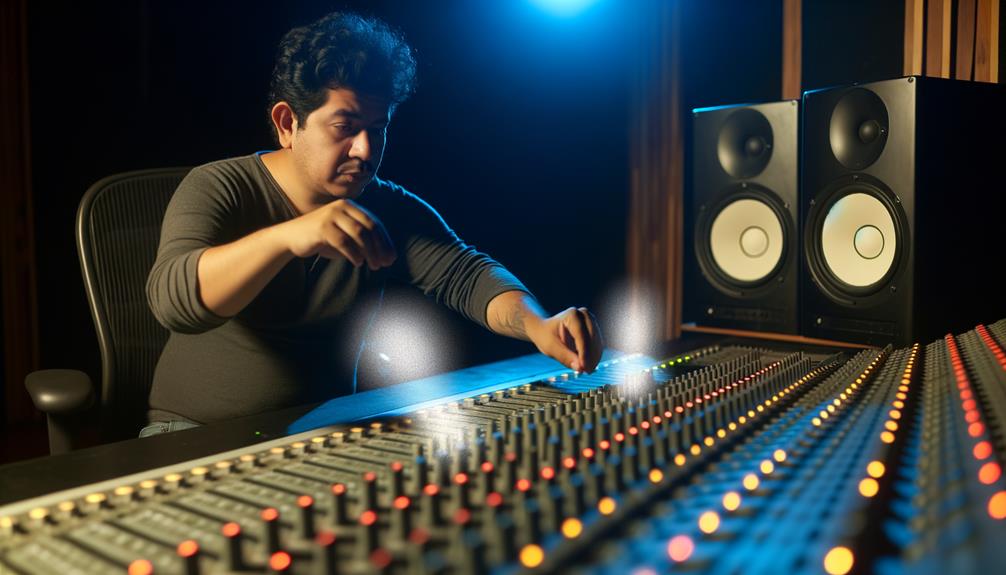No products in the cart.
To guarantee your master tracks with reverb, start by selecting the right reverb type. Hall reverb suits orchestral pieces, while plate reverb shines on vocals. Adjust reverb timing to match the track’s mood; longer times add expansiveness, shorter ones intimacy. Use pre-delay to keep vocals clear and separate from the reverb tail. EQ the reverb tail, cutting low frequencies to reduce muddiness and controlling high-end for brightness. Balance the dry and wet signals meticulously, starting with a lower wet signal for clarity. Lastly, make sure your track maintains its integrity in mono playback by regularly testing mono compatibility. These foundational tips will elevate your tracks, revealing a deeper layer of sound mastery in further exploration.
Contents
hide
Key Takeaways
- Utilize hall reverb for expansive orchestral tracks, enhancing depth and ambience.
- Adjust pre-delay to ensure vocal clarity and separation in the mix.
- Apply high-pass filtering on reverb tails to eliminate low-frequency clutter.
- Balance dry and wet signals carefully to maintain clarity while adding spatial effects.
- Regularly test mono compatibility to ensure reverb retains clarity and depth.
Select the Right Reverb Type
Choosing the appropriate reverb type—be it hall, plate, room, or spring—can greatly shape the spatial dynamics of your master track. Each type introduces unique reverb coloration choices that influence the overall sound quality. For instance, hall reverb, with its expansive and lush characteristics, is ideal for creating a deep, wide soundstage that enhances orchestral or ambient tracks. The long decay time envelops the sound in a rich, resonant tail, making it perfect for dramatic, sweeping sections.
Conversely, plate reverb offers a brighter, more controlled reverb effect, adding a metallic sheen that’s well-suited for vocals or snare drums. This type’s distinct high-frequency response can brighten up a mix, lending clarity and presence to lead elements.
For more intimate or smaller-scale productions, room reverb provides a more confined acoustic environment, reflecting the nuances of smaller spaces. This is particularly useful when you want to add a sense of immediacy or closeness to your sound, ideal for jazz clubs or tight pop mixes.
Spring reverb, with its distinctive twang and bounce, presents creative reverb applications especially in genres like rockabilly or surf rock, where its quirky, retro vibe can be fully leveraged to evoke a specific era or style.
Adjust Reverb Timing
Adjusting reverb timing allows you to manipulate the spatial dimensions and depth perception within your mix, tailoring the sound’s ambiance to match your artistic vision. By fine-tuning the duration of reverb, you’re effectively altering the perceived size and depth of the virtual space. Longer reverb times can imbue your tracks with a sense of expansiveness, ideal for creating atmospheric or ethereal effects. Conversely, shorter reverb times help sounds to remain more upfront and intimate, enhancing the clarity and presence of vocal or lead instruments.
Incorporating reverb modulation within your time-based effects toolkit enables dynamic shifts in ambiance. This technique involves varying the reverb timing at different points in your track, adding a layer of movement and complexity that can prevent your mix from sounding static or monotonous. Moreover, aligning reverb timing with the song’s tempo or rhythmic elements ensures that the space created by the reverb complements the musical context, enhancing the overall cohesion of your track.
Experiment with these strategies to effectively use reverb as a powerful tool in shaping the spatial narrative of your music, ensuring each element sits perfectly within the mix.
Use Pre-Delay Effectively
To effectively use pre-delay in your reverb settings, you’ll need to carefully time the onset of reflections to enhance vocal clarity and separation in the mix. Pre-delay shifts the start time of the reverberation effect, allowing the original sound to stand out before the reverb kicks in. This separation guarantees that your vocals remain clear and distinct, even in a dense mix.
Here are specific ways to optimize pre-delay:
- Experiment with different pre-delay lengths: Start with short delays and gradually increase to find the sweet spot where the vocals stand out without sounding disconnected.
- Use sidechain compression: Link the reverb to the vocal track so that the reverb level dynamically adjusts, prioritizing the dry signal.
- Adjust based on tempo: Tailor pre-delay settings to the song’s tempo; faster tempos might need shorter pre-delays.
- Listen for clarity and articulation: Ensure that the vocal’s articulation is preserved; too much pre-delay can detach the reverb from the source.
- Understand the impact of pre-delay on reverb timing: Recognize how altering pre-delay affects the overall reverb effect and timing, aiming for a natural yet prominent vocal presence.
EQ the Reverb Tail
When you’re adjusting the EQ on the reverb tail, it’s essential to manage tail frequency adjustments carefully to maintain the clarity and definition of your track.
By applying a high-pass filter, you can eliminate low-frequency rumble and avoid a muddy output that detracts from the overall mix.
Similarly, using a low-pass filter helps control excessive brightness and prevents the reverb decay from becoming too harsh or overpowering.
Tail Frequency Adjustments
By EQing the reverb tail, you effectively shape its decay to guarantee the reverberation blends seamlessly with your track’s overall sound. This process is important for maintaining clarity and preventing frequency clashes. Here are key steps for effective tail frequency adjustments:
- High-pass Filtering: Remove low-end rumble to prevent muddiness.
- Notch Filtering: Identify and reduce specific frequencies that muddy your mix.
- Boosting High Frequencies: Enhance airiness and presence without overwhelming the track.
- Cutting Mids: Reduce mid-range frequencies to clarify vocals or lead instruments.
- Tailoring Decay Time: Adjust the decay length to fit the tempo and mood of the track.
These techniques ensure your reverb tail complements, rather than competes with, your mix.
Avoid Muddy Outputs
Adjusting the EQ on your reverb tail is vital to avoid muddy outputs and maintain a clean, clear mix. By applying a high-pass filter to cut frequencies below 200 Hz, you’re enhancing clarity and improving definition in your tracks. It’s imperative to carve out space specifically for vocals and main instruments, guaranteeing they stand out without clashing.
| Action | Frequency Range | Purpose |
|---|---|---|
| Apply high-pass filter | Below 200 Hz | Remove low-end rumble |
| Carve out space | Specific to mix | Enhance vocal/instrument clarity |
| Tailor reverb EQ | Complementary | Improve definition, avoid frequency overlap |
| Enhance separation | Broad spectrum | Prevent sound elements from merging |
| Adjust for clarity | Targeted areas | Focus on critical mix points |
This targeted EQ approach prevents overlapping frequencies and ensures a polished, professional sound.
Balance Dry and Wet Signals
To achieve a cohesive mix with reverb, you must carefully balance the dry and wet signals, ensuring the original sound remains clear while adding necessary depth and space. This precision in signal blending is vital for mix cohesion, allowing each element to stand out without getting lost or overshadowed by the reverb.
Here are some key considerations for balancing your dry and wet signals:
- Start with Low Wet Signal Levels: Begin by setting a lower wet signal level and gradually increase it until you achieve the desired ambiance without compromising the clarity of the dry signal.
- Utilize Solo and Bypass: Regularly solo the track or bypass the reverb effect to directly compare the processed and unprocessed sounds. This helps in making informed adjustments.
- Adjust Pre-Delay: Setting the correct pre-delay helps in separating the dry signal from the reverb tail, maintaining clarity and preventing a washed-out sound.
- Use Automation: For dynamic parts of your track, automate the wet signal levels to maintain balance throughout the song.
- Reference Professional Tracks: Regularly compare your track with professionally mixed songs to understand how well your signals are balanced.
Automate Reverb Parameters
Automating reverb parameters allows you to dynamically tailor the intensity and spatial effects of reverb throughout your track, enhancing both movement and interest. By tweaking the decay time, pre-delay, and wet/dry mix over time, you can introduce a living, breathing quality to your soundscape. This approach not only keeps listeners engaged but also serves to highlight key moments or shifts within your track.
For instance, increasing reverb during a bridge or quiet passage can create a sense of expansion and depth, while pulling back during a chorus might sharpen and ground the overall mix. Additionally, exploring reverb modulation techniques can add a unique texture to your sound. Modulating parameters like diffusion or size in real-time can inject an ethereal or surreal quality to specific elements, making them stand out.
Engage in creative reverb routing by linking automation to your track’s panning controls. This method ensures that the reverb’s positioning in the stereo field matches the originating sound’s spatial characteristics. By automating the panning of reverb returns, you can enhance the stereo image and promote a cohesive spatial integration, avoiding disorientation and instead fostering a more immersive listening experience.
Test Mono Compatibility
Confirm you test the mono compatibility of your track by summing the stereo mix to mono, verifying that the reverb effects are preserved and clear. This process is vital to make certain that your mix sounds consistent across various playback systems, including those that output in mono. You’ll want to check phase relationships and avoid cancellation, particularly with the reverb, to maintain the intended spatial and depth effects that enhance your track.
Here are essential steps to ensure mono compatibility with reverb:
- Sum to Mono: Quickly convert your stereo track to mono to check how elements combine without stereo separation.
- Check Phase: Listen for phase issues that could cause reverb or certain frequencies to disappear.
- Listen for Reverb Clarity: Ensure the reverb isn’t muddying up in mono; it should remain clear and contribute to the depth as intended.
- Adjust Settings: If you notice issues, tweak reverb parameters—like pre-delay or decay time—to better suit mono playback.
- Regular Testing: Integrate mono compatibility checks at various stages of your mixing process to prevent last-minute surprises.
These steps will help you achieve a robust and consistent sound, whether your track is played on a club system, a smartphone speaker, or anything in between.
Frequently Asked Questions
Should You Add Reverb to Master Track?
You should cautiously add reverb to your master track to avoid pitfalls like muddiness, ensuring it enhances spatial clarity without overpowering. Tailor the mix percentage based on your specific genre for the best results.
What Reverb to Use for Mastering?
For mastering, you’ll want to use high-quality reverbs. Opt for transparent, room emulation types like algorithmic or convolution reverbs that provide detailed control over decay, pre-delay, and EQ settings.
What Should I Add to Master Track?
You should add subtle compression techniques and precise EQ adjustments to your master track. These enhance dynamics and balance frequencies, ensuring each element meshes well without compromising the track’s overall clarity and impact.
How to Make Reverb Sound Better?
To make your reverb sound better, focus on tailoring the reverb decay and adjusting pre-delay settings to fit the track’s rhythm and depth, ensuring a seamless blend without overpowering your mix.
Conclusion
Now that you’ve explored these techniques, you’re equipped to transform your master tracks. Remember, choosing the appropriate reverb type sets the stage, while fine-tuning the timing and pre-delay sharpens the spatial effects.
EQing the reverb tail removes muddiness, ensuring clarity. Balancing dry and wet signals maintains the original’s integrity, and automating parameters adds dynamic interest.
Always test mono compatibility to guarantee your track’s versatility. Apply these steps meticulously for a polished, professional sound in your music production.




